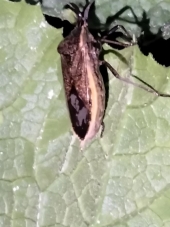Absurd question.... But I gotta ask. Does anyone have extensive knowledge of measuring the UV reflectivity of various materials ?? Anybody?
This is a long shot but I just have to ask. Here's the thing.... I know lots of you have the same problem that I do. Little green caterpillars are eating all your cabbages, broccoli etc. It sounds like most of you are having this problem because of 'cabbage moths' or the 'cabbage looper' moths. They all look the same to me. But I don't have any of those around here. Here, the caterpillars are from the 'White Cabbage Butterfly'. It's a small white butterfly with a couple of black spots on it's wings.
When I started gardening here 11 years ago I saw maybe 5-10 in a day. Not a big problem. But each year there are more. These last 2 years I see about 5-10 every minute. Maybe I'm just seeing the same 50 to 100 and they found my yard and won't leave. I usually spray my crops a few times each summer with Spinosad or Neem oil but this year they are unstoppable. I keep my brassicas in tunnels covered in bird netting when they are small and this has always kept out most of them. But these last 2 years they are all about ½ the size they used to be and they can go right through the bird netting. So I am trying to come up with a better way than putting solid covers over them which seldom works.
I have spent a lot of time researching online looking for real scientific evidence to fix this, not just anecdotal ideas that people keep passing around and never works. And I finally hit PAYDIRT!! Pun totally intended! I found Real science!
NEW ZEALAND HAS ERADICATED THE 'WHITE CABBAGE BUTTERFLY FROM THEIR ENTIRE COUNTRY! New Zealand is awesome! Granted, it only arrived there in 2010 and was only seen in 2 small areas but they used all the tools in their toolbox and eradicated them in just a few years before things got bad. They got the public involved, and sprayed the same organic insecticides that I do. Caught every one of them. Good job!! However, since they are everywhere here in America that wouldn't work for us. BUT....
It says in their report.....”Research was conducted to develop attractants for P. brassicae adults, but did not produce practicably useful results [45,46]. However in 2014 a DOC staff member, W. Wragg, developed an ultra-violet (UV) reflective lure that was attractive to P. brassicae adults. Its efficacy was optimised by measuring the UV reflectivity of various materials [47] to identify one with similar reflectivity to P. brassicae wings [48,49]. A cloth with suitable UV reflectivity was glued to ornamental butterflies’ wings, which moved by solar power, and the models were used to attract P. brassicae adults towards staff with nets.
The UV lures were first deployed in October 2014 when detection rates had already declined to low levels (Fig 2). Pieris brassicae adults approached the lures in a manner similar to P. rapae [48,62], but never alighted on them. From 10 October 2014 to 3 November 2014, it took 180 person-hours to capture three P. brassicae adults without a lure, whereas it took 44 person-hours to capture seven with a lure.”
Here is the report from New Zealand if anyone wants to read it....
https://journals.plos.org/plosone/article?id=10.1371/journal.pone.0236791 accept the cookies.
So again, my question is 'Does anyone have extensive knowledge of measuring the UV reflectivity of various materials'? If someone can replicate the reflective material, why can't we build a simple trap. The material would lure the butterfly in to.... a bug zapper?, a bowl of water to drown in?, something. Do the wings have to flap by solar power or could it be just as simple as a small piece of paper on a bobby pin moving in the wind?
If we all put our heads together we could create and manufacture these..... and solve my problem..... and we can patent it and agree to give all the proceeds to Permies. Just a crazy idea but I had to try.
Sidenote- I took a stupid anecdotal suggestion off the internet last year and planted lots of catmint all around my yard because they said that it's super-duper at attracting lots of great pollinators. So far they are only attracting the damned 'white cabbage butterfly'! You can't see them all in this picture because they wouldn't leave the bush and fly. They refused to obey my command! I would send 'Mother Nature' another complaint but I think she's gone off her meds right now!

 3
3

















 2
2









 2
2




 Fun can be had!
Fun can be had!

 2
2




 2
2











 3
3











